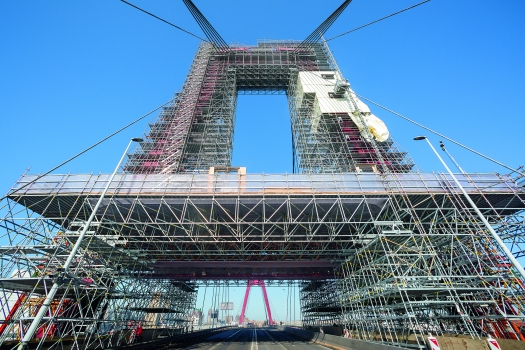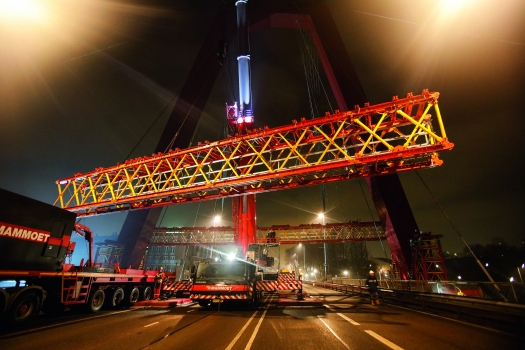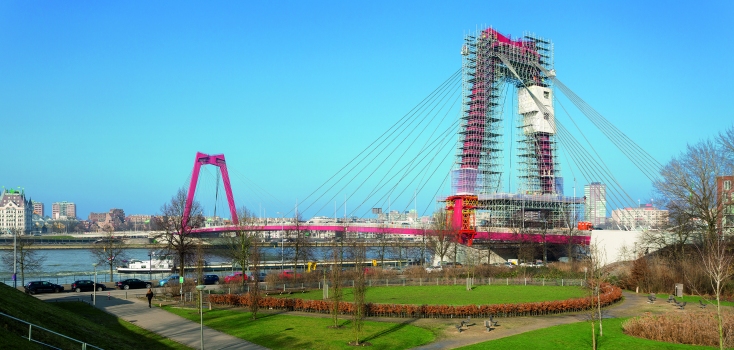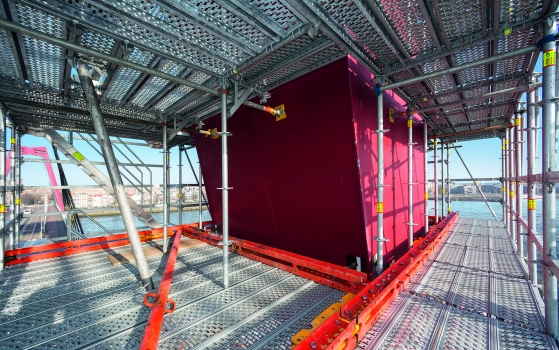Challenging pylon scaffolding on Rotterdam's Willems Bridge
The refurbishment of the pylons on Rotterdam's Willems Bridge proved to be a tremendous challenge for installing the scaffolding. All scaffolding and painting work had to be carried out without any major negative impact on the flow of traffic in the city.
Media
The Willems Bridge is situated in the centre of the Dutch metropolis, Rotterdam. Besides the Erasmus Bridge and the Maas Tunnel, it is one of the most important road links between the northern and southern parts of the city. The striking cable-stayed bridge over the River Maas with its two red, 60 m high steel pylons had to be renovated, therefore sandblasted and repainted. In order to ensure safe execution of the painting work, the southern pylon of the suspension bridge was scaffolded first and then the northern pylon. The pylon refurbishment was carried out on behalf of the Municipality of Rotterdam by the Venko company while Steigerbouw Van der Panne was responsible for the scaffolding work.
One of the most difficult scaffolding projects in the Netherlands
Installing the scaffold on the Willems Bridge was considered one of the most difficult scaffolding projects ever seen in the Netherlands. One of the requirements was that all scaffolding and painting work had to be carried out without any major negative impact on the flow of traffic in the city. As the entire superstructure is not only freely suspended through the stay cables, it was also not possible to set up the approx. 200 t scaffold construction for each respective pylon on the carriageway slab – a major challenge for all project participants.
Assembling the truss girders in only one night
Only one night was available for assembling the truss girders for bridging the carriageway of the structure. The girder package was therefore pre-assembled at the PERI facilities in Schijndel – each girder having a length of 21 m – and transported to the site on a heavy-duty truck. On reaching their destination, these units were quickly lifted by a mobile crane onto the heavy-duty towers positioned on the sides as well as on shoring and working scaffold temporarily erected in the middle of the bridge, and then coupled by means of bolts. At 6 o'clock in the morning the bridge could be re-opened. Traffic could then flow freely underneath the over 40 m high freely-supported truss girder bridging.
Parallel to the “VARIOKIT” heavy-duty truss girder construction for the wide-span bridging and support structure above the bridge carriageway, the “LGS Lattice Girder System” was also used for scaffolding the pylon legs. As a result, it was possible to realize a projecting 10 m protective roof construction on both sides. In addition, a working platform with a span of 12 m could be installed between the pylon legs. This platform moved upwards step by step in the wake of the fast scaffolding erection progress until reaching its designated final height of 50 m.
Special anchoring concept due to high wind loads
In order to hermetically seal off the working area from the road traffic as well as preventing any building and waste material from falling into the river, the working scaffold was completely enclosed with a shrink foil. In conjunction with the enormously high wind loads that had to be taken into consideration as a result of the Maas estuary entering the North Sea, this also required a correspondingly adapted anchoring concept.
Together with the scaffolding specialists from Steigerbouw Van der Panne, PERI engineers designed an overall solution that was optimally adapted to meet project requirements, and which was based on two combinable modular systems. The “PERI UP Flex Modular Scaffolding System” provided flexible adaptation possibilities to match the pylon geometry and thus ensuring safe working levels including access technology. Truss girders and heavy-duty shoring towers taken from the “VARIOKIT Engineering Construction Kit” facilitated the transfer of the high loads across the entire width of the carriageway. A working scaffold was subsequently erected on this and loads were laterally transferred via the pylon foundations. A closed, generously-sized cantilevered intermediate level stretched over the supporting structure and reliably shielded the moving traffic below as well as the pedestrian and cycle paths from the refurbishment measures and also served as a protective structure during scaffolding operations. With special drop tests using heights of more than 50 m, the protective effect was already proven in advance.
References
Structure Types
- About this
data sheet - Product-ID
7583 - Published on:
08/03/2018 - Last updated on:
20/03/2018











